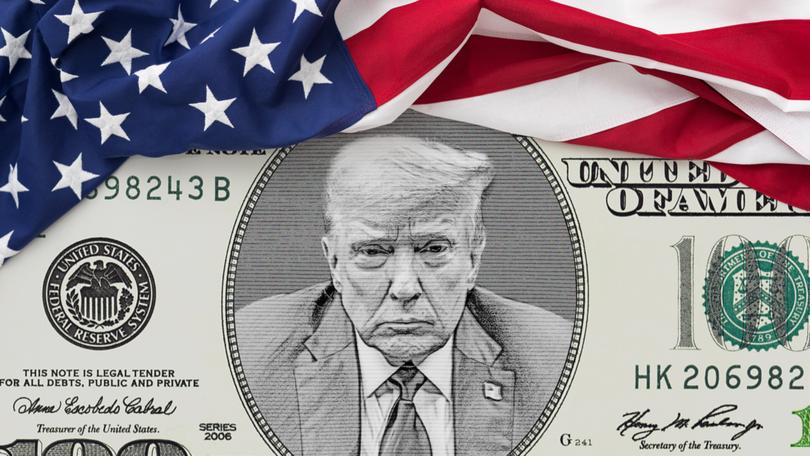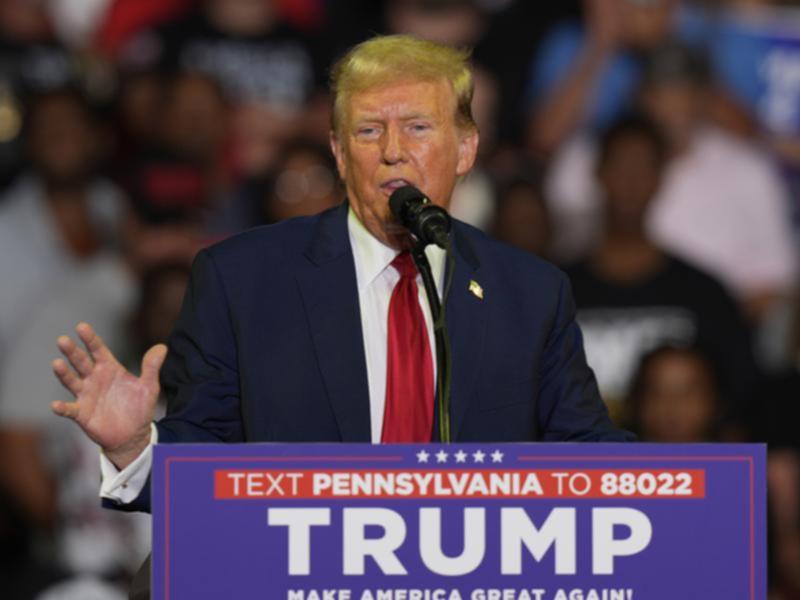Donald Trump’s expected return to the White House causes run of ‘Trump Trading’

In markets it is known as the “Trump trade”, a bet that Donald Trump’s return to the White House would herald more inflation and higher interest rates.
Many of Mr Trump’s core policies push in this direction: tariffs would add to import costs, deportations of immigrants could push up wages and deficit-financed tax cuts would juice the economy. Amid mounting inflation, the Federal Reserve would have little choice but to opt for higher rates.
In the wake of Joe Biden’s calamitous debate on June 27th, a preview of the trade played out.
Sign up to The Nightly's newsletters.
Get the first look at the digital newspaper, curated daily stories and breaking headlines delivered to your inbox.
By continuing you agree to our Terms and Privacy Policy.As investors grappled with the likelihood that Mr Trump would romp to the presidency, they sold off Treasuries, which led to a brief surge in yields. The big fear is that much worse would come to pass.
If Mr Trump fought the Fed on rates, he might sow doubts about the central bank’s independence, undermining confidence in America’s markets and the dollar. That is the economic nightmare scenario for a second Trump administration.
But as with any nightmare, the bogeyman of Trumponomics may be more terrible than its reality.

Mr Trump and his advisers have many rotten ideas. They also have some decent ones. And their ability to implement damaging policies will be constrained, with Congress, America’s institutions and markets all serving as checks.
Mr Trump has honed his agenda in speeches and interviews, and on July 8th it was enshrined by Republicans as the party’s election platform.
Three elements stand out.
The first is deregulation, a staple for Republicans.
In contrast to 2017, when he and his advisers were ill-prepared for the presidency, this time they have lined up personnel and policies.
Mr Trump will waste little time in rescinding many of the Biden administration’s environmental rules, easing drilling restrictions for oil companies and putting pressure on federal agencies to cut spending.
He has promised, as in his first presidency, to eliminate two regulations for each one issued.
But much of this is marketing buzz. The number of restrictions in the Code of Federal Regulations, a proxy for the intensity of regulation in America, was unchanged under Mr Trump. What is more, his administration was stymied by the courts.
It was unsuccessful in nearly 80 per cent of litigation over its use of federal agencies, according to the Institute for Policy Integrity, a research group.
Goldman Sachs, a bank, reckons that the impact of all Mr Trump’s deregulation was ultimately insignificant for the wider economy—a result likely to be repeated.
On tax, Mr Trump can, in some sense, be seen as a continuity candidate. Action will focus on the looming expiration of much of the Tax Cuts and Jobs Act, Mr Trump’s package from 2017.
The TCJA’s reduction in corporate taxes was permanent, but much of the rest of the law, including cuts to personal income taxes, will expire at the end of 2025. Mr Trump’s main objective is to make these cuts permanent.
That will not be simple because to get the bill through Congress, Republicans will need to pay the cost of extending the cuts, about $US4.5trn over the next decade. But Mr Trump has options. One slug of revenue may come from tariffs, which could bring in $US3trn over the decade.
There is also money in reversing some of Mr Biden’s policies.
The cost of the Inflation Reduction Act, Mr Biden’s climate-subsidy package, is expected to reach about $US1trn.
Republicans can eliminate some tax credits, starting with discounts for electric vehicles. Mr Trump has also suggested he may unwind Mr Biden’s student-debt cancellations, on track to cost $US1trn.
Mr Trump’s other tax ideas are more modest. He has talked about shaving a percentage point off the corporate tax rate, to cut it to 20 per cent (he likes a round number).
His zaniest proposal is to make tipping exempt from taxes. Legislators would have to craft that exemption carefully, otherwise, everyone might demand to pay as gratuities.
Without offsetting revenue or spending cuts, every tax cut will make America’s deficit worse, a risk under Mr Trump. But it is not as if Mr Biden has been a paragon of fiscal rectitude: the federal deficit is on track to hit a hefty 7 per cent of GDP this year.
Tariff man, part two
The economic strategy for which Mr Trump is most infamous, especially outside America, is his protectionism.
He has been clear about where he wants to go next, aiming for a 10 per cent universal tariff on all imports into America and a 60 per cent levy on Chinese-made goods. He also wants a more concerted decoupling from China.
There is no doubting the global fallout if Mr Trump were to deliver on his panoply of America-first trade policies. Would he be able to do so?
In the traditional wing of the Republican Party, there is still resistance to tariffs. If Mr Trump decides to cut Congress out of the picture, he may declare a national security emergency, which would give him special powers. That, however, may be struck down in court.
Higher tariffs on China would be more achievable since the White House could piggyback them on existing measures. It could, for instance, conclude that China has not lived up to a deal signed with Mr Trump in 2020, which would be easy to demonstrate.
Cracking down on the rerouting of Chinese exports via other countries would be harder without cooperation from foreign governments, which Mr Trump has struggled to elicit in the past.
Moreover, even within Mr Trump’s White House, there may well be opposition to his most aggressive trade policies. Hawks such as Peter Navarro, an economic adviser, have been the most voluble, but Mr Trump likes to assemble a team of rivals, letting him adjudicate between contrasting opinions.
He may once again appoint a Wall Street veteran as his treasury secretary and such a figure would be a counterweight to fire-breathing protectionists.
Mr Trump’s agenda will face other hurdles. He wants to hit the ground running but his first year in office features a dense legislative calendar. The debt ceiling will be reinstated on January 2nd, forcing the White House to enter talks with Congress.
Another deadline looms at the end of April when Congress will have to make swingeing cuts if it has not worked out a new budget.
All the while, the clock will be ticking on Mr Trump’s tax cuts. If the Democrats manage to win the House, all of these negotiations will be that much thornier. Mr Trump will make even less headway on reshaping the Fed. Investors worry that he wants to influence the central bank’s rate decisions.
Putting that desire into practice, though, is difficult.
His first chance to appoint a new governor will come in 2026, after which he can also nominate a chair to replace Jerome Powell. But the Fed’s board is seven-strong and all nominations must go through the Senate, which previously blocked two of Mr Trump’s four nominees.
If Mr Trump tried to fire Mr Powell, insiders at the Fed think that he would have another unwinnable legal fight on his hands.
Perhaps the biggest short-term damage that Mr Trump can inflict on America’s economy is through his immigration policy. Stopping “the invasion”, as he calls it, will consume his administration.
The millions who have entered the country in the past few years have been vital to sustaining economic growth while taming inflation. A halt to migration would be a shock to the labour market. Nevertheless, as with other Trumpian policies, there will be resistance every step of the way, with courts striking down deportation orders, Democrat states refusing to cooperate and businesses lobbying for a lighter touch.
Through all of this, the financial world would also rein in Mr Trump. He is sensitive to the stock market, even ascribing its good run earlier this year to expectations of his victory.
Were equities to fall or yields to soar when Mr Trump attacks his latest target—whether the Fed, migrants or foreign trade—it would catch his attention.
This is not to be sanguine about Mr Trump’s hold over American politics. There is a risk that his second term will spiral out of control.
Checks on his excesses are not automatic and would need people to go against him in the Republican Party, the courts and society at large. But that ought to happen, which would keep the worst of Trumponomics at bay.
